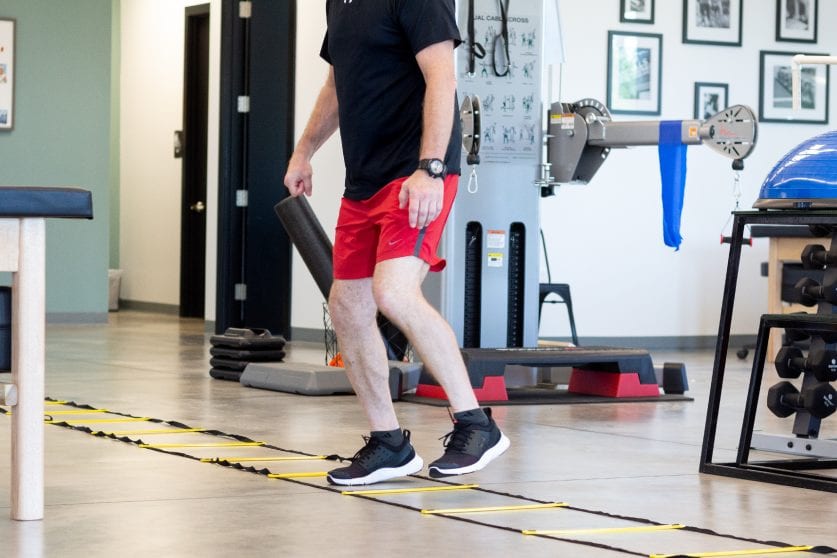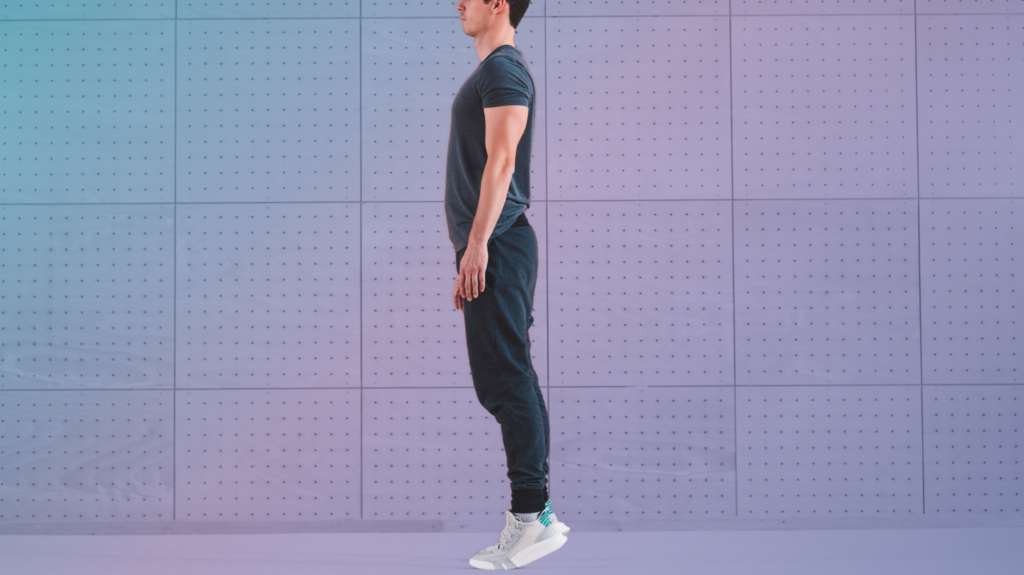- Performance of Home Exercise Program (HEP)
Ah, the home exercise program — or, as we call it in the physical therapy world, HEP. A home exercise program is a prescribed set of exercises that are to be performed by the patient on the days when they are not in physical therapy.
A home exercise program may consist of an array of exercises from stretching, range of motion, and strengthening. These exercises are given to help progress the patient’s rehabilitation towards their functional goals. A home exercise program is not designed to consume a lot of time. Taking as little as 15 minutes of time a day to perform the HEP is beneficial.
- Eat Healthy/Get Proper Nutrition
Eating a balanced diet impacts overall health and is especially important in the healing process after an injury. This section does not consider every individual’s dietary needs. It is just an overview of general nutrition and how it can affect healing. As you can see from the following infographic, nutrients play a role in healing. Having the right balance can help promote a good healing environment for your injured tissues.
| Nutrients | Healing Functions | Some Food Sources |
| Protein | Tissue growth, repair, and maintenance | Red meat, poultry, fish, beans, eggs, nuts, deeds, milk and foods made with milk |
| Iron | Transportation of oxygen to body cells, helps form the structure of hemoglobin | Red meat, eggs, fortified cereals, spinach, potato, avocado |
| Zinc | Physical growth, wound healing | Red meat, chicken, oysters, fortified cereals, lentils, almonds, chickpeas, yogurt |
| Copper | Collagen formation (connective tissue) | Whole grain products, seafood, oysters, nuts, seeds |
| Vitamin C | Collagen formation (connective tissue), scar tissue, bone growth and repair, iron absorption, antioxidant, helps fight off infection | Citrus fruit and juice (lemon, orange, grapefruit), papaya, green peppers, strawberries, Brussels sprouts, tomatoes, cabbage, spinach, potatoes, cauliflower |
| Vitamin A | Epithelial cell (skin tissue) formation, helps fight off infection | Green and yellow vegetables, yellow fruits, fortified margarine, butter, egg yolks, fortified milk, fish |
| B Vitamins | Helps the production of red and white blood cells, aids in antibody formation | Yeast, leafy green vegetables, beans, lean meats, milk, eggs, cheese, whole grains |
| Vitamin E | Antioxidant (helps to stop cell damage) | Vegetable oils, vegetables, wheat germ, whole grain products, nuts, fruits, meats |
- Adequate Sleep/Rest
Rest is an important factor in the rehabilitation of an injury. Unfortunately, it is something we don’t get enough of, whether we are injured or not.
Sleep is vital to the body’s restorative and healing processes. The Centers for Disease Control and Prevention recommends that adults get 7–9 hours of sleep per night. Our bodies heal during sleep, releasing hormones such as the Human Growth Hormone (HGH). HGH is responsible for the growth and repair of our body’s tissues.
Additionally, when HGH is released, cortisol levels drop. Why is this important? During times of stress, like an injury, cortisol levels increase. High cortisol levels can create stress on the body and lead to symptoms like fatigue, weight gain, depression, and increased blood pressure.
- Consistently Showing up for Appointments
Your physical therapy appointments are the first step on the journey to recovery. Your physician has prescribed a set amount of physical therapy visits a week for a reason — it is important to keep the appointments.
Think about physical therapylike a gym: you don’t become stronger or look better if you don’t go and workout at the gym. If you’re consistently participating in therapy, you begin to heal and become stronger and more mobile. You won’t heal properly or return to your pre-injury self if you do not consistently attend your therapy sessions.
- Understanding Healing Time Frames
One of the most-asked questions therapists receive is, “How long until I am better?” The question has no finite answer and unfortunately, we cannot give a concrete date.
Everyone heals at different rates and many factors can impact how long it takes us to heal. Factors such as age, genetics, fitness level, nutrition, and other co-morbidities, such as cardiovascular disease or diabetes, can all play a factor in healing. Below is a handy chart showing how long it takes for certain body tissues to heal, it does not account for having to regain strength or motion.

- A Positive Attitude
Attitude is very important. Have you ever gone into a situation with a negative attitude? Did you get the result you were expecting? Likely, you did not!
Attitude has a lot to do with everything in life and it is equally important in physical therapy. Your therapist knows you are in pain and that you may be limited in your daily activities, which can dampen an attitude.
A positive attitude creates a better experience for you and helps you put in your best effort. At Foothills Sports Medicine, we strive to make therapy a supportive environment conducive to your healing — leaving you feeling better physically and emotionally.
- The “No Pain, No Gain” Mantra is False
We have all heard the mantra “no pain, no gain.” But, it is not true in physical therapy. Pain is a warning from the body. Pain is defined as “an unpleasant sensory and emotional experience associated with actual or potential tissue damage or described in terms of such damage,” by The International Association for the Study of Pain.
We know that many factors can affect the intensity of pain, like stress, fear, social issues, or physical changes. It is part of our jobs to help figure what is causing your pain and help create strategies to alleviate that pain.
This can be achieved in one of many ways: through modalities such as ice, ultrasound or electrical stimulation; range of motions exercises; strengthening, joint mobilization, or soft tissue work. While exercises or manual therapy performed by the therapist may be uncomfortable, therapy should never cause you more pain than you started when you walked in the door of the clinic.
- Physical Therapy: It’s Not Just Exercise
Physical therapy is more than just exercise, period! While exercises such as resisted exercises and stretching are part of physical therapy, we do more.
First, we provide education about your injury or ailment, the progression of exercise, and time frames of healing. We are also educated professionals with advanced degrees about the human body. We provide hands-on treatments such as mobilization of joint, corrections of body mechanics, and progression of rehabilitation programs to obtain your functional goals.
- The Numeric Pain Scale
If you have ever been injured before you’ve been asked, “on a scale of 0–10 how bad does it hurt?” This scale can be frustrating because it is very subjective and each of us experiences pain differently.
The numeric pain scale is a quick and easy reference tool to help the clinician establish the intensity of one’s pain on a moment-to-moment and day-to-day basis. Reporting a 0 out of 10 indicates that you are not experiencing any pain. While a report of 10 out of 10 indicates you are in excruciating pain. In a 10 out of 10 pain, you would experience pain to such a degree that you couldn’t imagine it could be worse or are unable to care for yourself and require immediate medical attention to relieve your pain.
- Goal Setting
In physical therapy, goal setting is creating a set of activities that are important and meaningful for the patient to return to. These goals should be functional.
Functional goals are those activities that are essential to a patient’s physical, social, and psychological well being and create a personal sense of meaningful living. These functional goals help us, as clinicians, establish and progress your rehabilitation plan to get you to your goals.
Above are the 10 things I wish my patients knew or would do. The items on this list are a small part of the foundation for a successful outcome in physical therapy. Just as I put my knowledge and best effort forth daily, I too hope my physical therapy patients will do the same. It is my hope that when you apply the above content, you will achieve better results and stay healthy. If you’re searching for a physical therapist in the area, take the first step and find a clinic near you.




